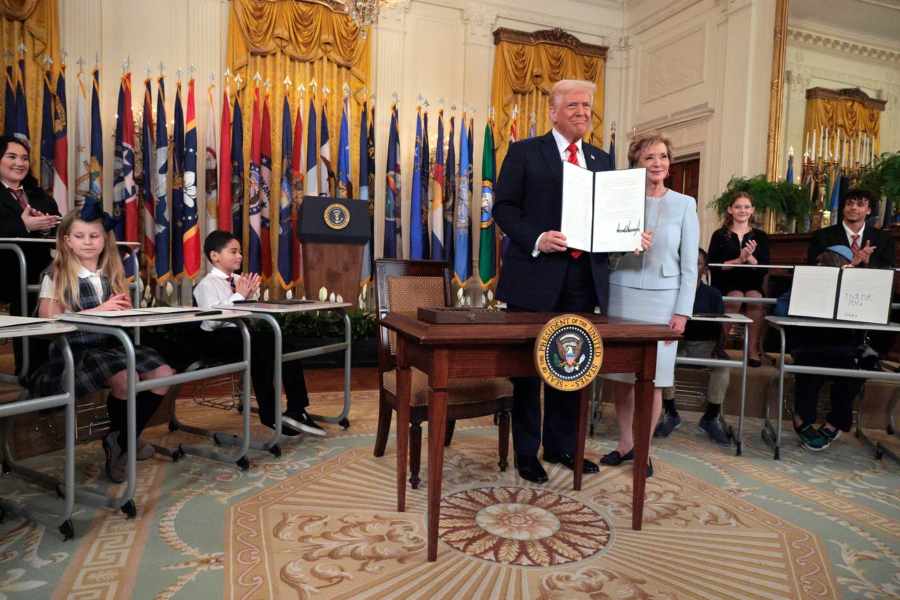In a move set to redefine the structure of American education, President Donald Trump will sign an executive order on Thursday to begin dismantling the Department of Education, according to a statement from the White House. The order, a long-held ambition of conservative lawmakers, is expected to mark the beginning of a broader effort to return control of education policy to individual states and local communities.
The announcement comes after weeks of internal planning, and the signing event at the White House is expected to include several prominent Republican governors, including Florida Gov. Ron DeSantis, a former rival of Trump. “President Trump’s executive order to expand educational opportunities will empower parents, states, and communities to take control and improve outcomes for all students,” White House spokesperson Harrison Fields said in a statement on Wednesday.
However, eliminating the Department of Education would require congressional approval, and the outcome of that legislative battle remains uncertain. While Republicans have long sought to decentralize federal oversight of education, previous efforts to dissolve the department have failed due to political and logistical challenges. The move is expected to face fierce opposition from Democrats and public education advocates, who argue that federal oversight is necessary to maintain equitable education standards across all states.
The effort to dismantle the department dates back to President Ronald Reagan’s administration when conservatives first proposed shifting education policy away from federal authority. Now, under Trump’s leadership, the idea is gaining renewed momentum. Hours after Education Secretary Linda McMahon was confirmed by the Senate, she issued a memo titled “Our Department’s Final Mission.” In the memo, she called for a legacy of lasting change: “This is our opportunity to perform one final, unforgettable public service to future generations of students. I hope you will join me in ensuring that when our final mission is complete, we will be able to say that we left American education freer, stronger, and with more hope for the future.”
The administration has assured the public that key programs such as student loans, Title I funding for low-income school districts, and the Individuals with Disabilities Education Act (IDEA) will remain intact, despite the dissolution of the Education Department. However, it remains unclear which federal agencies will take over these programs once the department is officially dismantled. One potential avenue, according to President Trump, is shifting responsibility for student loan management to existing economic agencies. “Student loans could be brought into either Treasury, the Small Business Administration, or Commerce,” Trump previously stated.
The decision to dismantle the Department of Education has sparked significant debate. Republican lawmakers and school choice advocates have hailed it as a major win for states’ rights and local control, arguing that individual communities are better equipped to make decisions that affect their students. “This is about putting control back into the hands of parents and local educators,” said House Speaker Mike Johnson. “For too long, Washington bureaucrats have dictated education policy without understanding the needs of our children.”
Democrats and education advocacy groups are strongly opposing the move, warning that dissolving the Department of Education could have devastating consequences for federal education funding, oversight of civil rights protections, and support for special education programs. Senate Majority Leader Chuck Schumer criticized the decision, calling it “a reckless, ideological attack on public education.” “This administration is attempting to dismantle a system that provides crucial resources to disadvantaged students across the country. This is an assault on equal opportunity and educational equity,” Schumer said.
If fully implemented, the dissolution of the Education Department would mark one of the most significant shifts in federal education policy in modern history. While some states have robust education funding and oversight mechanisms, others rely heavily on federal support to ensure quality education for all students. Critics warn that without a central authority, disparities in education funding and quality could widen dramatically between wealthier and poorer states.
Education policy analysts are also raising concerns about what will happen to programs designed to address racial and economic disparities in education. Title I funding, for instance, provides billions of dollars to support low-income school districts, and many worry that states may lack the infrastructure to manage such programs effectively. Meanwhile, supporters argue that states should have the autonomy to direct education funds where they see fit, without federal mandates or regulations restricting their approach. “States know their students best, and they should be making these decisions—not bureaucrats in Washington,” said former Education Secretary Betsy DeVos, a longtime proponent of school choice and voucher programs.
Although the executive order will initiate the process of dismantling the Education Department, the outcome is far from certain. To formally eliminate the department, Congress must pass legislation, and the proposal is likely to face strong resistance from Democrats, education advocacy groups, and civil rights organizations. Legal challenges are also expected. Several states and education unions are preparing lawsuits to block the order, arguing that removing federal oversight violates students’ constitutional rights and undermines educational equity.
The timeline for implementation remains unclear, as congressional approval and legal battles could delay the process for months or even years. In the meantime, education policy experts predict that schools, teachers, and students will face uncertainty as they wait for further clarity on how the transition will unfold.
Trump’s move to dismantle the Department of Education is a bold and controversial step that could reshape American education policy for generations. While supporters see it as a victory for local control, opponents argue that it threatens fundamental protections for students, particularly those in marginalized communities. As the political and legal battles unfold, the future of education in the United States hangs in the balance. Will the executive order lead to a complete dissolution of the Department of Education, or will opposition forces succeed in preserving federal oversight? One thing is certain: the stakes for students, parents, and educators have never been higher.
